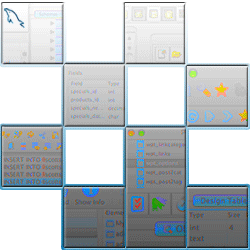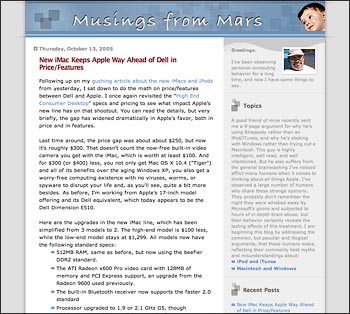Articles In Category
Aqua Data Studio: Query and Data Model Analyzer
DbVisualizer: New Version of Universal Database Management Tool
What’s The Best Mac Database Tool for MySQL?
Although I’ve been  developing websites with MySQL for over 7 years now, until recently I had almost always used phpMyAdmin to manage my databases. phpMyAdmin is such an excellent web application and makes managing MySQL so easy that the only time I strayed was when it wasn’t available on the host server (which was very rare). When I needed a desktop MySQL client, I had turned to YourSQL, which I determined a couple of years ago was the best for me when connecting to MySQL from Mac OS X.
developing websites with MySQL for over 7 years now, until recently I had almost always used phpMyAdmin to manage my databases. phpMyAdmin is such an excellent web application and makes managing MySQL so easy that the only time I strayed was when it wasn’t available on the host server (which was very rare). When I needed a desktop MySQL client, I had turned to YourSQL, which I determined a couple of years ago was the best for me when connecting to MySQL from Mac OS X.
For various reasons that I won’t bore readers with here, I found myself needing a Mac desktop client for MySQL again recently, so I took the opportunity to review the market once again. What surprised me most, I suppose, is how many options there are for Mac OS X users who do a little light database work. (Caveat: I am by no means a database administrator, and my knowledge of SQL and MySQL is merely sufficient to develop web applications—meaning, I can build tables, relate tables, and build queries for those tables. The tools reviewed here are from this use case alone.) In the course of testing, I tried out nine different database apps:
PHP Class To Convert MySQL to JSON
Well, That Took Longer Than I Thought!
This is a tale of two blogs: Blogger, and WordPress. When I looked around for blogging tools and software last March, I settled on Blogger (now owned by Google) because it looked like I could get up and running very quickly. And I did! I don’t think it took me more than a week to customize an existing template and choose the few options available to get something I was pleased with.
Blogger is kind of like Apple’s .mac HomePage tool… mostly, you just point and click and make the best of the few options you have. Still, with very little effort you can end up with something that looks very professional. In my review of tools, I noted wistfully the powerful features of WordPress and Movable Type. As a guy who likes to program and play with code–especially with PHP and MySQL–those two blogging systems loomed on the net like two giant chocolate ocean liners. But I knew I had to be strong and ignore them, in order to get the blog up with a minimum of effort.

At the time, I also looked at desktop blogging tools and settled on Ecto, which I’ve been very pleased with. My only complaint is that Ecto’s developer updates the software so often I’m always having to download new versions! But it’s not really much of a complaint, since I’m very happy the tool keeps getting better.
So, with Blogger and Ecto in hand, I happily began writing down many things, delighting in my newfound ability to express my rants in a more disciplined form. As the number of articles grew, however, I started bumping up against the one feature of Blogger that bothered me in the beginning: No categories. As of this writing, Blogger offers no way to organize posts into categories or to tag them with keywords. This is a pretty serious deficiency, but it only has an impact after you’ve written more than a dozen posts or so, or if you’ve started covering more than one subject area.





